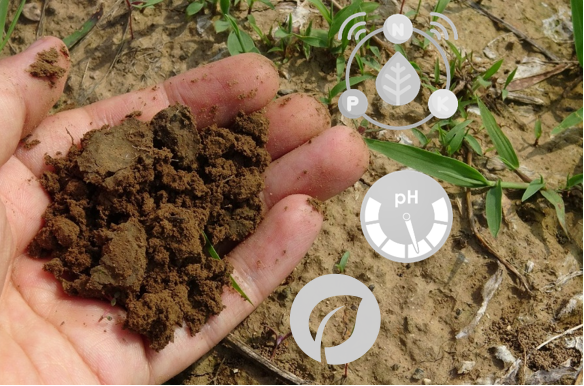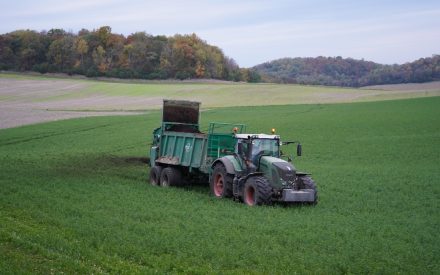Many decisions are made and dollars are spent based on soil test results. Soil tests, at a minimum, measure nutrient levels for phosphorus (P), potassium (K), pH, and organic matter. In addition to these, other commonly tested metrics include calcium and magnesium (with cation exchange capacity and percent base saturation), sulfur, and micronutrients. Given the importance to crop and soil health and crop productivity, the accuracy of soil test results cannot be overstated. Whether you take your own soil samples or have the fertilizer dealer sample your fields for you, how soil is collected really matters.

How soil sampling can affect lab results
The goal is to collect a soil sample that represents the area of the field where it was taken and to ensure the sample is representative of that area in the same way every time it is sampled. Let’s explore the various ways in which sampling can affect soil test results and some key items to keep in mind.
Number of Cores Per Sample
Collecting one soil core is not adequate to capture the variability within the field and represent that entire area. Research has shown that taking 10-20 cores per sample are needed to provide a representative sample of a section of a field compared to less than 10 cores. The 10-20 core amount properly accounts for the high- and low-testing areas in the field: therefore, minimizing the effects of soil variability at the lab. Thoroughly mix the cores and then fill the soil test bag with approximately 2 cups of soil.
Proper Number of Samples Per Field
The minimum number of samples in Wisconsin is 1 sample for every 5 acres. However, less samples are needed for larger fields with low variability. Similarly, fields with greater variability might require a greater number of samples or dividing the field into zones for sampling. Avoid sampling unusual spots: abnormal plant growth or visual soil color/texture differences, end-rows or areas of heavy equipment traffic, wet spots, highly eroded areas, locations of former farmsteads or animal enclosures, within 100 ft. of roads, areas where lime or manure was stacked before application, and fertilizer bands. If the “abnormal area” is large enough, consider submitting as a separate sample.
Sampling Depth
Proper and consistent sampling depth is crucial to a representative sample. Soil pH, organic matter and nutrient levels can change with depth and management practices. The top 6 inches of soil has the most root activity, organic matter, and nutrient/manure applications. Collect soil samples to your plow depth (see chart below). Take soil samples in following years to the same depth to allow for future comparisons of the same field.
| System | Recommended Soil Sampling Depth |
|---|---|
| Plowed Ag Fields | Sample to depth of plowing (usually 6-8 inches) |
| Minimum or No-till systems | 2-4 inches for pH; 8 inches for fertilizer recs |
| Perennial crops or Orchards | 6-8 inches for seeding; 4 inches for maintenance applications |
| Lawn | 4-6 inches |
Deeper subsoil samples may be used for specific soil tests, including: a 0-12” for pre-sidedress nitrate tests (PSNT), or 0-12” and 12-24” for preplant nitrate test (PPNT) Hint: mark your soil probes at the desired depth to maintain consistent sampling in the field.
Soil Sample Angle
The angle at which soil cores are collected during soil sampling can affect the lab results. A vertical core provides a precise profile of soil layers, maintaining the integrity of the lab analysis. Taking a soil core at an angle affects the sampling depth and might miss soil layers, which can skew the representation of soil properties and nutrient levels.
Frequency of Sampling
In Wisconsin, it is recommended ag soils be tested every 4 years to monitor soil fertility and pH levels. Crop nutrient removal over a 4-year timeframe in most row crop systems will not change soil test levels enough to affect recommendation rate category. There are some exceptions.
Crops with high removal rates (corn silage, alfalfa) may require more frequent testing to monitor P and K levels. Sands and loamy sands should be tested every 2 years since their nutrient content and pH can change faster than other soils due to their lower buffering and cation exchange capacities. Yearly soil testing is common on high-dollar crops grown in irrigated sandy fields. This is due to the low nutrient-holding capacity of sandy soils and testing earlier will assist you meeting crop need.
Optimal Timing for Soil Sampling
Collect samples early enough to allow for interpretation and applications of fertilizer and/or manure. To compare soil test results between years, it is recommended to sample at the same time of the year as you sampled last time. The most common are spring or fall soil sampling.
Spring or pre-planting is ideal for determining the nutrient needs before planting crops. It provides a snapshot of the soil’s nutrient status after winter and helps in planning the season’s fertilization strategy. Spring soil samples should be done well in advance of planting or spring green-up.
Post-harvest or fall soil sampling is commonly used for assessing nutrient depletion after the growing season. Fall sampling helps in understanding the residual nutrient levels and planning for soil amendments during the off-season and provides more time for applications. Overall, it is best not to sample soils which have been recently fertilized, manured or limed.
Typically, hayfields can be sampled after any cutting. Regardless of when you sample, it is best to be consistent.
Seasonal Variations in Soil Properties
Studies examining the effect of spring vs fall suggest that soil test values for pH and phosphorus (P) are typically higher in early spring samples than fall. Soil test potassium (K) results may be higher in the spring compared to fall on lower testing soils (somewhat more common in sands) but on higher testing soils, soil test K may be lower in the spring compared to fall are dependent on clay minerology and soil test level.
Here are some key ways seasonal conditions can influence outcomes:
- Spring: Nutrient levels can be higher due to recent applications of fertilizers and organic amendments. Soil temperatures are also lower, which can slow down microbial activity, decomposition and nutrient cycling.
- Summer: Warmer temperatures increase decomposition, microbial activity can lead to nutrient N-depletion, especially in actively growing crops.
- Fall: Often reveals nutrient depletion from crop uptake. Sampling immediately after corn grain harvest vs waiting a month will result in significantly result in different soil test potassium levels in weather extremes you may want to re-check K level again in spring.
- Winter: Soil sampling is not recommended on frozen ground due to difficulty obtaining proper representative samples.
pH Levels
Soil pH can also vary with season due to changes in temperature, moisture, and biological activity. For instance, rainfall can lower soil pH by leaching away basic cations, while drought conditions can lead to slightly higher pH levels.
Conclusion
Soil sampling and testing is foundational to crop production. By understanding and implementing proper soil sampling methods, you can ensure your soil test results truly reflect your fields. Keep in mind to collect 10-20 cores, at the proper depth, with the proper angle, at the season that fits your farm. Remember, the reliability of soil test results begins with how the soil is sampled—take the time to do it right.
While soil samples can be sent to any laboratory, it is important that the samples are sent to a lab that uses procedures that follow the Wisconsin recommendations, especially for use in nutrient management plans. Check that your current lab provider that they are a Wisconsin certified soil testing lab.
More Information
Sampling Soils for Testing (A2100)
Chapter 2 Nutrient Application Guidelines for Field, Vegetable, and Fruit Crops in Wisconsin (A2809)

 BMPs of NMPs #6: On-Farm Implementation of Nutrient Management in Southwest WI
BMPs of NMPs #6: On-Farm Implementation of Nutrient Management in Southwest WI


